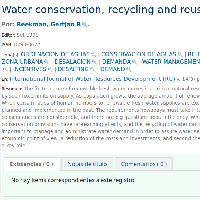Resumen
- The finite nature of renewable fresh water makes it a critical natural resource to examine in the context of population growth. Few other resources so essential to daily life are bounded by such fixed limits on supply. As population grows, the average amount of renewable fresh water available to each person declines, constraining efforts to improve health and living standards. When certain ratios of human numbers to renewable fresh water supplies are exceeded, water stress and outright scarcity are all but inevitable. The era of big water schemes is ending, as planned and implemented in the past. The requirements nowadays must take into consideration hard facts, such as that costs are increasing in real terms, the environmental and social consequences are considerable, and there are big questions about efficiency. What does work is the kind of careful conservation practised by an increasing number of water users. Water conservation provisions have far-reaching effects, and the recycling of water can be considered as a renewable source of water. Slowly, a growing awareness is taking shape that it is more important to manage and administrate water demand in order to assure water security, than to meet the growing demands at any cost. Thereby, two goals will be achieved: first, from the economic point of view, a reduction of the costs and investments, and second the protection and conservation of the environment. In this respect, conservation, recycling and reuse of water play a key role.
